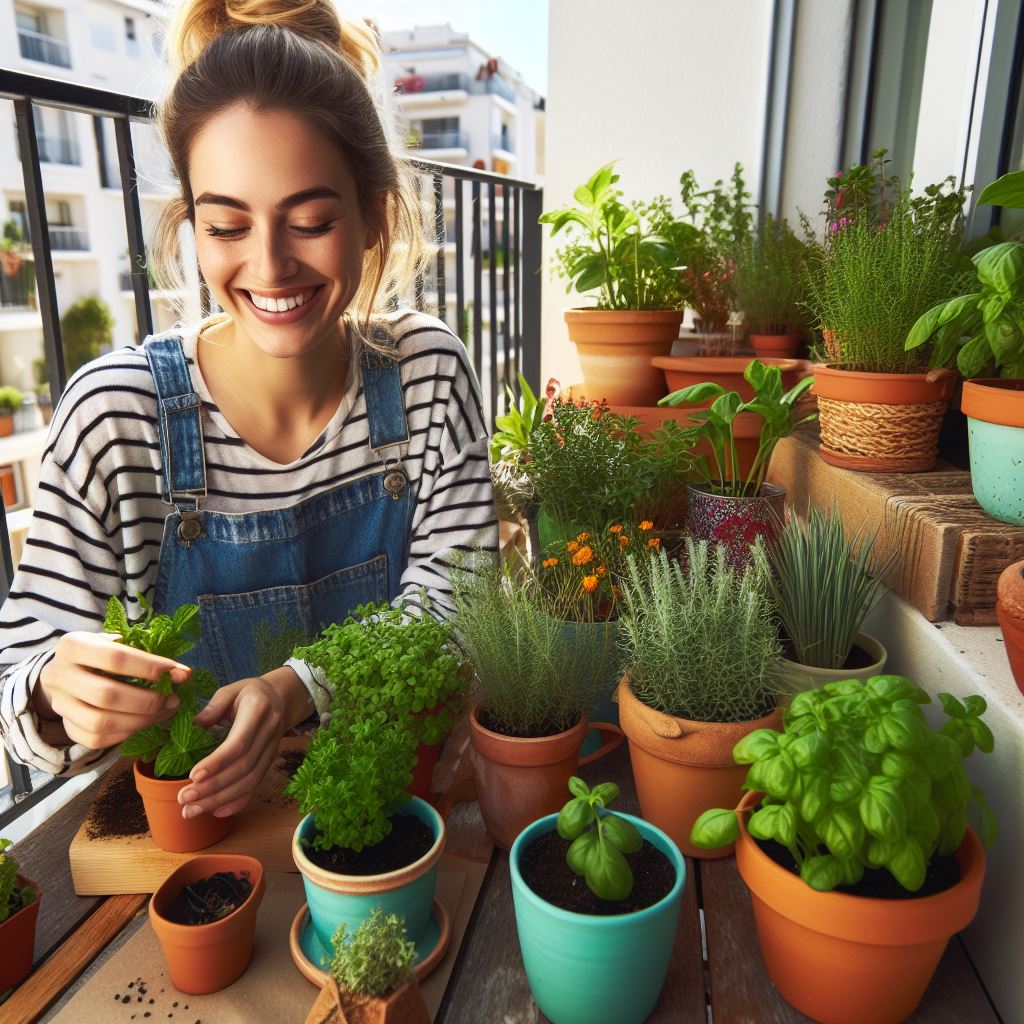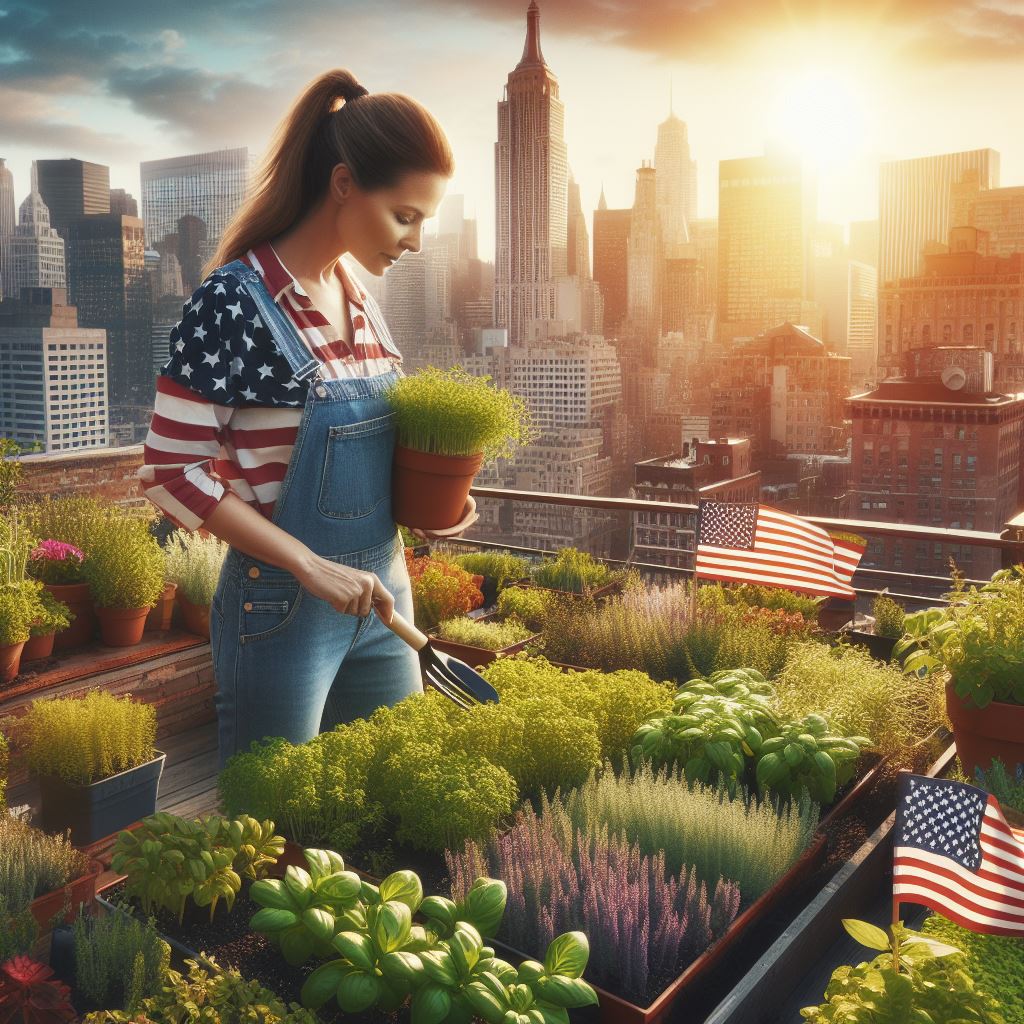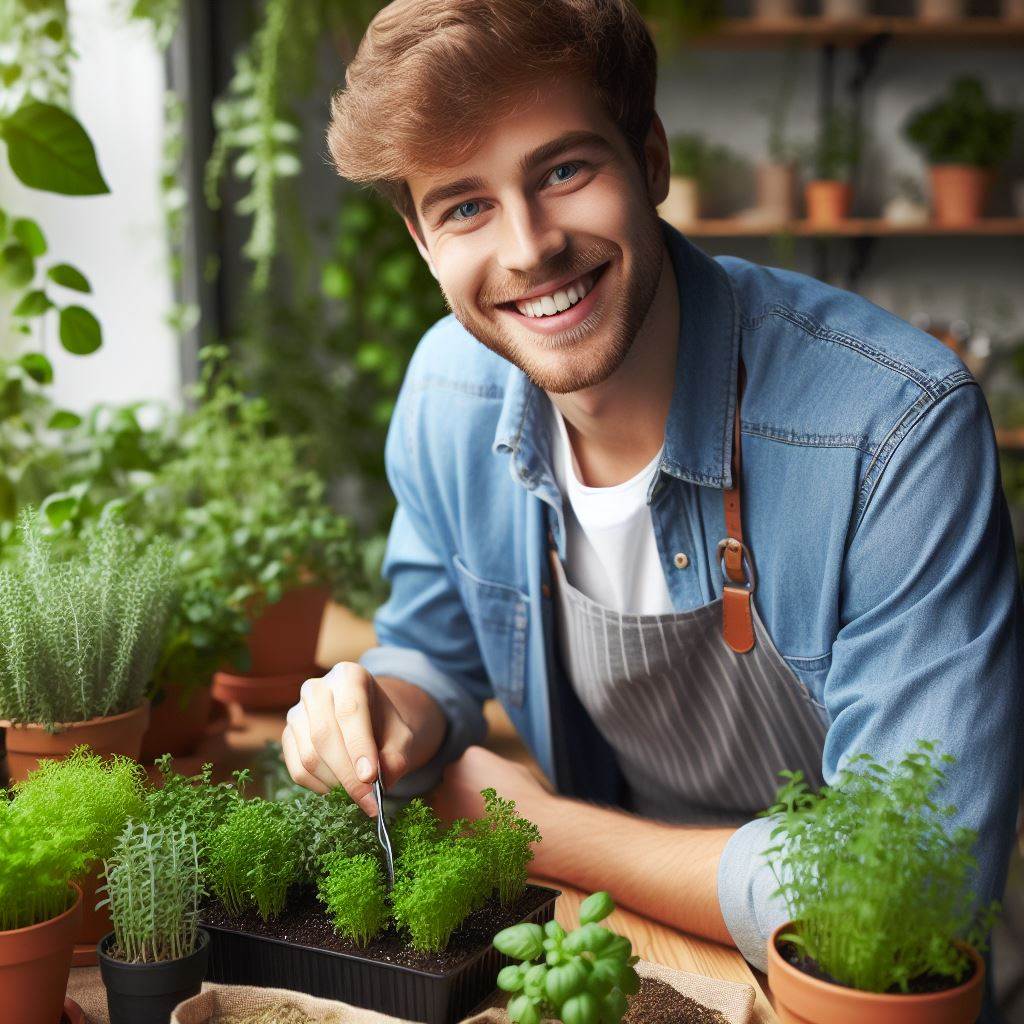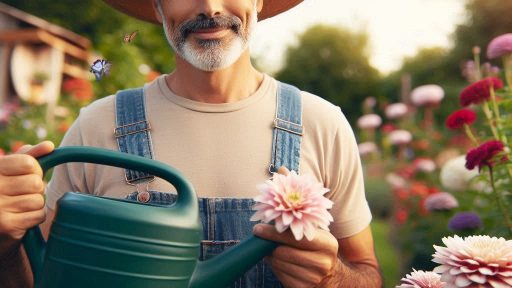Introduction
The practice of growing herbs in pots has gained significant popularity in recent years, and for good reason.
With urbanization and limited space becoming increasingly common, many people are unable to have traditional gardens.
However, herb growing in pots provides a practical solution for individuals with space constraints or those living in apartments.
Compact gardening offers numerous benefits to gardeners, regardless of their available space.
Pots are portable, allowing herbs to be moved around to optimize sunlight exposure, resulting in better growth.
Unlike traditional gardening, where herbs are limited to one location, pots can be placed anywhere – on windowsills, balconies, or even indoors.
This ensures that herbs can be grown year-round and easily accessed for use in cooking or for medicinal purposes.
Herbs grown in pots require less maintenance compared to a larger garden.
With a compact garden, there is less weeding, no need for excessive watering, and a reduced risk of pests and diseases.
This makes herb growing in pots an ideal option for individuals with limited time or those with physical limitations.
Basically, this blog post aims to emphasize the importance of herb growing in pots and the benefits of compact gardening.
Whether you live in a small apartment or simply want to enjoy fresh herbs year-round, herb growing in pots is a practical, accessible, and rewarding endeavor.
Stay tuned for more tips and advice on how to make the most of your compact garden!
Choosing the Right Pots
In order to successfully grow herbs in pots, it is crucial to choose the right pots that will provide the necessary conditions for your plants to thrive.
This section will guide you through the process of selecting suitable pot materials, determining appropriate pot sizes, and ensuring proper drainage for your pots.
Transform Your Agribusiness
Unlock your farm's potential with expert advice tailored to your needs. Get actionable steps that drive real results.
Get StartedSelecting Suitable Pot Materials
When it comes to choosing pot materials for growing herbs, there are several options to consider:
- Terracotta pots: These clay pots are a popular choice due to their natural appearance and good drainage capabilities.
- Plastic pots: Lightweight and durable, plastic pots are also a common choice. Look for ones with drainage holes.
- Fabric pots: Made from breathable fabric, these pots promote better root aeration and prevent overwatering.
- Ceramic pots: These pots come in various designs and colors, adding aesthetic appeal to your herb garden.
The choice of pot material ultimately depends on your personal preference, budget, and the specific needs of your herbs.
Determining Appropriate Pot Sizes
Choosing the right pot size is crucial for the healthy growth of your herbs.
Here are some factors to consider:
- Herb type: Different herbs have different root systems. Smaller herbs like basil require smaller pots, while larger herbs like rosemary may need larger pots.
- Maturity stage: Consider the current size of your herbs and their potential growth in the future. Allow enough room for root expansion.
- Number of plants: If you plan to grow multiple herbs in one pot, make sure it is large enough to accommodate their combined root systems.
- Space availability: If you have limited space, choose smaller pots or consider vertical gardening options.
Providing enough space for your herbs to grow and thrive is essential for their overall health.
Ensuring Proper Drainage for Pots
Proper drainage is crucial for preventing waterlogged soil, which can lead to root rot and other plant diseases.
Here are some tips:
- Drainage holes: Ensure that your pots have sufficient drainage holes to allow excess water to escape.
- Drainage layers: Place a layer of small rocks or broken pot shards at the bottom of the pot to improve drainage.
- Soil mixture: Use a well-draining potting mix that allows water to flow freely through the soil.
- Elevate pots: Avoid placing pots directly on surfaces that can trap excess water. Use pot feet or saucers to elevate them.
- Watering techniques: Water your herbs thoroughly but avoid overwatering. Allow the top inch of soil to dry out before watering again.
By ensuring proper drainage, you can prevent water-related issues and promote the healthy growth of your herbs.
Remember, choosing the right pots is essential for the success of your herb garden.
Consider the pot materials, sizes, and drainage requirements to provide the best conditions for your herbs to thrive.
Read: Easy Herbs for Window Gardening Success
Essential Growing Conditions
A successful herb garden in pots relies on meeting certain essential growing conditions to ensure the health and productivity of your plants.
In this section, we will discuss the sunlight requirements for different herbs, recommended soil types and mixtures, appropriate watering techniques, and the ideal temperature and humidity levels.
Sunlight requirements for different herbs
- Mint: Mint prefers partial shade and can tolerate a few hours of direct sunlight each day.
- Basil: Basil loves full sun and requires at least six to eight hours of direct sunlight.
- Thyme: Thyme requires full sun and at least six hours of direct sunlight per day.
- Parsley: Parsley thrives in partial shade and can tolerate around four hours of direct sunlight daily.
It’s important to know the specific sunlight requirements of the herbs you are growing to ensure their optimal growth and flavor.
Recommended soil types and mixtures
The right soil type and mixture are crucial for the health and development of your potted herbs.
Here are some recommended options:
- Peat Moss mix: Ideal for herbs that prefer moist soil, such as mint and parsley.
- Sandy Loam mix: Perfect for herbs that require well-draining soil, like thyme and rosemary.
- Potting mix: A general-purpose mix suitable for most herbs, providing good drainage and nutrient retention.
Choose the appropriate soil type and mixture based on the specific needs of your herbs to promote their overall growth and vitality.
Appropriate watering techniques
Watering your potted herbs correctly is vital to prevent under or over-watering, which can lead to various issues.
Follow these watering techniques:
- Check soil moisture: Stick your finger one inch deep into the soil to check if it feels dry before watering.
- Water thoroughly: Ensure water reaches the entire root zone by watering until it flows out of the drainage holes.
- Avoid waterlogging: Ensure pots have proper drainage to prevent excess water accumulation.
- Establish a watering schedule: Develop a routine based on your herb’s moisture requirements, typically every 2-3 days.
Proper watering techniques will keep your herbs hydrated without causing root rot or dehydration.
Ideal temperature and humidity levels
The temperature and humidity levels in your herb garden directly influence growth and overall health.
Consider the following factors:
- Temperature: Most herbs thrive in temperatures between 60-75°F (15-24°C). However, they can tolerate slight variations.
- Humidity: Different herbs have varying humidity preferences, but generally, a humidity level of 40-60% is ideal.
Keep your herbs away from extreme temperature fluctuations and ensure proper air circulation to maintain an optimal growing environment.
By understanding and providing the essential growing conditions for your potted herbs, you will set the stage for a flourishing and bountiful garden.
Showcase Your Farming Business
Publish your professional farming services profile on our blog for a one-time fee of $200 and reach a dedicated audience of farmers and agribusiness owners.
Publish Your ProfileRemember to tailor these conditions to the specific needs of each herb, ensuring you create the ideal environment for them to thrive.
Read: Micro Farming: Grow More in Less Space
Selecting and Cultivating Herbs
Researching and choosing herb varieties
- Start by researching different herb varieties to determine which ones will thrive in your climate.
- Consider the flavor profiles and culinary uses of the herbs to choose the ones that suit your preferences.
- Look for herbs that are easy to grow and resistant to common pests and diseases.
- Consider the space you have available and choose herbs that can be grown successfully in pots.
- Consult gardening books or websites for specific information on each herb’s growing requirements.
Planting seeds or seedlings in pots
- Once you have selected your desired herb varieties, it’s time to start planting.
- Fill your pots with well-draining potting soil, leaving about an inch of space at the top.
- If planting seeds, follow the instructions on the seed packet for the appropriate planting depth and spacing.
- If using seedlings, gently remove them from their nursery containers and place them in the prepared pots.
- Water the newly planted seeds or seedlings thoroughly and place them in a sunny location.
Providing necessary care and maintenance
- Herbs grown in pots require regular watering to ensure they do not dry out.
- Check the moisture level of the soil by sticking your finger about an inch deep into it. Water if needed.
- Herbs also benefit from regular fertilization to promote healthy growth. Use a slow-release fertilizer according to package instructions.
- Prune your herbs regularly to encourage bushier growth and prevent them from becoming leggy.
- Remove any dead or yellowing leaves to maintain the overall health and appearance of the plants.
Understanding growth habits and pruning needs
- Each herb has its own growth habits and pruning needs, so it’s important to familiarize yourself with them.
- For example, some herbs, like basil, benefit from pinching off the tips to promote branching and prevent flowering.
- Mint and chives may need frequent pruning to keep them from taking over the pot and crowding out other herbs.
- Some herbs, like rosemary and thyme, have woody stems that can be pruned back in early spring to promote fresh growth.
- By understanding the specific needs of each herb, you can ensure they thrive and provide you with abundant harvests.
Remember, selecting and cultivating herbs in pots requires careful research, proper planting techniques, and ongoing maintenance.
With the right information and care, you can enjoy a compact herb garden that adds freshness and flavor to your meals.
Read: Grow Herbs on Your Porch: Simple Techniques
Maximizing Space in Compact Gardens
Utilizing vertical gardening techniques
- Install trellises and stakes to support climbing plants like cucumbers, beans, and tomatoes.
- Use hanging baskets or wall-mounted planters to grow herbs such as mint, thyme, and parsley.
- Train vining herbs like oregano and sage to grow on a decorative lattice or mesh.
Grouping compatible herbs together
- Consider the sunlight and water requirements of herbs when grouping them together.
- Group herbs that have similar growth rates and heights to make the most of limited space.
- Avoid planting aggressive herbs, like mint, with others as they can quickly overtake the garden.
Companion planting for improved growth
- Plant basil alongside tomatoes to enhance the flavor and repel pests.
- Pair chives with carrots to deter carrot flies.
- Interplant lavender with roses to attract beneficial pollinators and repel aphids.
Utilizing mobile containers for flexibility
- Use wheeled planters or carts to easily move herbs around for optimal sun exposure.
- Take advantage of movable raised beds or planters on wheels to accommodate changes in the garden layout.
- Utilize container planters that can be easily repositioned based on changing light conditions.
Multi-tiered plant stands for increased growing space
- Invest in tiered plant stands or shelves to maximize vertical growing space.
- Place smaller pots or trays on each level to grow a variety of herbs simultaneously.
- Ensure proper drainage and stability of the plant stand to prevent accidents and plant damage.
Utilize hanging pocket planters for small spaces
- Hang pocket planters on fences, walls, or balcony railings to grow herbs in minimal space.
- Choose plants that have shallow root systems to thrive in these compact planters.
- Regularly water and fertilize plants in pocket planters to ensure their healthy growth.
Incorporate window boxes for herbal abundance
- Install window boxes outside kitchen windows to grow herbs conveniently within reach.
- Select herbs that tolerate partial sunlight if the window receives limited direct sunlight.
- Remember to water the herbs frequently as window boxes tend to dry out quickly.
Interplanting herbs within vegetable beds
- Intersperse herbs between vegetables to maximize usage of limited garden space.
- Plant cilantro near lettuce to provide shade and prevent early bolting.
- Keep in mind the growth habits and soil preferences of each herb to ensure compatibility.
By implementing these space-saving techniques, compact gardeners can cultivate a lush herb garden in limited areas.
Whether utilizing vertical space, grouping compatible herbs, or incorporating companion planting, maximizing space is the key to a thriving herb garden.
With careful planning and creative ideas, even the smallest gardens can be transformed into bountiful havens of fresh herbs.
Read: Urban Veggie Gardens: Small Spaces, Big Yields

Harvesting and Utilizing Fresh Herbs
Knowing the right time to harvest herbs
- Regularly monitor your herbs for signs of maturity, such as full leaves and vibrant colors.
- Harvest herbs in the morning when the essential oils are at their peak for more intense flavors.
- Avoid harvesting herbs when they are wet as this can lead to mold growth and spoilage.
Proper techniques for harvesting herbs
- Use sharp, clean scissors or pruners to cut herbs just above a leaf node to encourage bushier growth.
- Cut herbs just above where new growth is occurring, which will help promote continuous harvesting.
- Remove any yellowing or damaged foliage to ensure the health and vitality of your herbs.
Storing and preserving herbs for later use
- Rinse herbs gently to remove any dirt or insects and pat them dry with a clean kitchen towel.
- Option 1: Place herbs in a damp paper towel, roll tightly, and store in a plastic bag in the refrigerator for up to a week.
- Option 2: Freeze herbs by chopping or blending them with a small amount of oil or water and storing in ice cube trays.
Culinary and medicinal uses of different herbs
- Basil: Add to salads, pasta sauces, or make pesto. Helps ease digestive issues and promotes mental clarity.
- Rosemary: Perfect for roasted meats, potatoes, and bread. Boosts memory and concentration.
- Thyme: Enhances the flavor of soups, stews, and grilled vegetables. Has antimicrobial properties and aids digestion.
- Mint: Great for cocktails, teas, and desserts. Relieves indigestion and soothes headaches.
- Sage: Enhances poultry, stuffing, and winter dishes. Supports cognitive function and reduces inflammation.
- Parsley: Adds freshness to salads, marinades, and garnishes. Supports kidney health and reduces bad breath.
Knowing the right time to harvest herbs
Harvesting and utilizing fresh herbs from your compact garden allows you to enhance the flavor and health benefits of your culinary creations.
By knowing the right time to harvest, using proper techniques, and storing them correctly, you can enjoy the aroma and taste of fresh herbs year-round.
When it comes to harvesting herbs, keep a close eye on your plants’ development.
Wait until they have reached their peak maturity, characterized by lush leaves and vibrant colors.
Early morning, after the dew has dried, is the optimal time to harvest herbs as their essential oils are at their highest concentration, resulting in more intense flavors.
Proper techniques for harvesting herbs
To ensure a successful harvest, use sharp and clean scissors or pruners to cut the herbs just above a leaf node.
This technique promotes bushier growth and encourages continuous harvesting throughout the growing season.
Remove any yellowing or damaged foliage to maintain the health and vitality of your herbs.
Storing and preserving herbs for later use
Properly storing and preserving your harvested herbs is essential to keep them fresh for later use.
Begin by gently rinsing the herbs to remove any dirt or insects.
Pat them dry with a clean kitchen towel to prevent moisture-induced spoilage.
There are two popular methods for preserving herbs:
- Option 1: Place the herbs in a damp paper towel, roll it tightly, and store it in a plastic bag in the refrigerator. This method can keep herbs fresh for up to a week.
- Option 2: Freeze the herbs by chopping or blending them with a small amount of oil or water.
Transfer the mixture into ice cube trays and freeze them.
These herb cubes can be conveniently used in cooking by adding them directly to your dishes.
Culinary and medicinal uses of different herbs
Different herbs offer unique flavors and medicinal properties.
Basil, with its sweet and spicy taste, is perfect for salads, pasta sauces, and homemade pesto.
It also aids digestion and promotes mental clarity.
Rosemary, known for its robust flavor, complements roasted meats, potatoes, and bread.
This herb is also believed to boost memory and concentration.
Thyme, with its earthy flavor, enhances the taste of soups, stews, and grilled vegetables.
It possesses antimicrobial properties and aids digestion.
Mint, renowned for its refreshing taste, can be used in cocktails, teas, and desserts.
By familiarizing yourself with the proper techniques for harvesting, storing, and utilizing fresh herbs, you can elevate your culinary skills and enjoy the numerous health benefits these aromatic plants offer.
Common Pests and Diseases
Common pests in potted herb gardens
- Aphids: Small, soft-bodied insects that feed on plant sap, causing leaves to curl and turn yellow.
- Whiteflies: Tiny, moth-like insects with white wings that suck sap from leaves, leading to stunted growth.
- Spider mites: Almost invisible pests that create fine webbing on plants and cause yellowing and wilting.
- Thrips: Small insects that feed on leaves, causing silvering or stippling on the surfaces.
Natural methods for pest control
- Introduce beneficial insects: Attract ladybugs and lacewings to your garden, as they feed on common pests.
- Use homemade sprays: Create a mixture of water and dish soap to spray on plants, suffocating pests.
- Sprinkle diatomaceous earth: Apply a thin layer of this natural powder to repel and kill crawling insects.
- Plant deterrents: Herbs like basil, catnip, and peppermint help repel pests when planted near affected plants.
Preventing and treating common diseases
- Powdery mildew: Fungal disease causing a powdery white coating on leaves. Improve air circulation and avoid overhead watering.
- Root rot: Fungus that thrives in damp conditions, leading to rotting roots. Water plants properly and avoid overwatering.
- Leaf spot: Fungal disease causing brown, black, or purple spots on leaves. Remove affected leaves and improve air circulation.
- Rust: Fungal disease forming orange or brown spore masses on leaves. Remove infected leaves and avoid overhead watering.
- Prevention is key: Ensure proper plant nutrition, avoid overcrowding, and maintain good hygiene in your garden.
By being proactive in pest control and disease prevention, you can maintain healthy and thriving potted herb gardens.
Regularly inspect your plants for any signs of pests or diseases and take immediate action.
Remember to use natural methods whenever possible to maintain an eco-friendly garden. Happy herb growing!
Troubleshooting and Common Mistakes
Recognizing and addressing common issues
- Wilting leaves: Check the soil moisture and adjust watering accordingly to prevent over or under-watering.
- Yellowing leaves: This could be a sign of nutrient deficiency or pests. Use organic fertilizers and inspect plants for any pests.
- Stunted growth: Lack of sunlight or overcrowding can hinder herb growth. Ensure each plant has enough space and access to sunlight.
- Root rot: Overwatering and poorly drained soil can lead to root rot. Improve drainage and reduce watering frequency to prevent this issue.
- Fungal diseases: Powdery mildew and leaf spot are common fungal diseases in herb pots. Use organic fungicides and remove affected leaves promptly.
Avoiding common mistakes in herb growing
- Choosing the wrong pot size: Select pots that provide enough space for herb roots to grow and allow proper drainage.
- Poor soil quality: Use well-draining soil mixes specifically formulated for herbs to ensure optimal growth.
- Over-fertilizing: Excessive use of fertilizers can cause nutrient buildup or burn the herbs. Follow recommended dosage and frequency.
- Neglecting pruning: Regularly pruning herbs promotes healthy growth and prevents them from becoming leggy.
- Overcrowding: Avoid planting too many herbs in one pot, as they compete for nutrients and space. Provide adequate spacing between plants.
Learning from experience and seeking advice
- Observe and adapt: Pay attention to your plants’ needs and make adjustments accordingly based on their growth and health.
- Research and learn: Explore different herb varieties and their specific care requirements. Stay informed about common issues and solutions.
- Seek advice from experts: Join gardening communities or seek guidance from experienced herb growers to gain valuable insights.
- Experiment and innovate: Don’t be afraid to try new techniques or combinations of herbs. Learn from both successes and failures.
- Keep a gardening journal: Document your experiences, including mistakes and their solutions, to track your progress and improve over time.
Remember, growing herbs in pots requires patience and attention to detail.
With proper troubleshooting and by avoiding common mistakes, you can enjoy a thriving herb garden in your compact space.
Happy herb growing!
Conclusion
It allows easy access to fresh herbs for culinary delights and medicinal purposes.
With minimal space requirements, even urban dwellers can enjoy the benefits of a herb garden.
Showcase Your Farming Business
Publish your professional farming services profile on our blog for a one-time fee of $200 and reach a dedicated audience of farmers and agribusiness owners.
Publish Your ProfileDon’t hesitate to begin your compact herb garden journey today.
Start small with a few favorite herbs, and gradually expand as your confidence grows.
You’ll be amazed at the satisfaction and joy that cultivating your own herbs can bring.
Choose the right pot size and soil mix for optimal growth.
Ensure adequate sunlight and water, but avoid overwatering to prevent root rot.
Regularly harvest your herbs to encourage new growth and prolong the plant’s lifespan.
Experiment with different varieties and enjoy the endless culinary possibilities.
Remember, gardening is a journey of learning and discovery—embrace the process and have fun!
In a nutshell, herb growing in pots is a rewarding endeavor suitable for gardeners of all levels.
By following these tips and embracing the benefits, you can create a thriving compact herb garden right at home.




